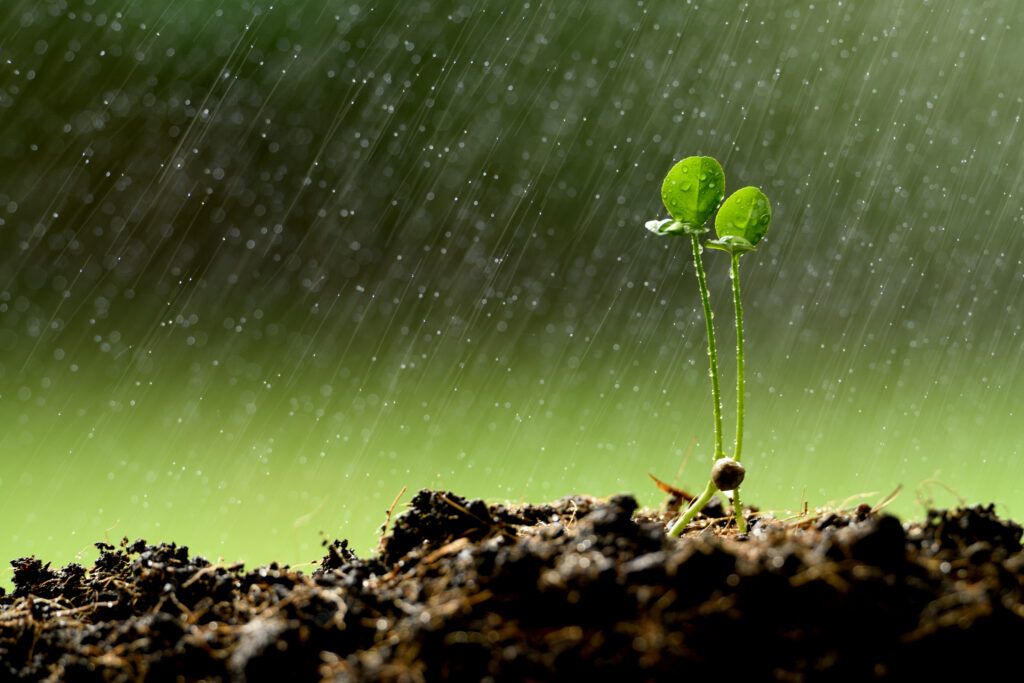
As spring finally arrives in typical Maryland style – downpours – people take comfort in these wet days by dreaming of the blooms that the rain nurtures. However, a new study by an Earth System Science Interdisciplinary Center researcher published in Nature Reviews Earth & Environment shows that whether rainfall comes as drizzle events or downpours matters for plant growth.
“Plants across Earth care a lot about how rainfall is delivered to its rootzone from day to day, and not just the total amount it rains over a season or year,” says Andrew Feldman, first author on the paper. “Typically, more rainfall over a year will make plants happier and the ecosystem can support more vegetation. However, plants can shift their photosynthesis and growth by 10% to 30% if their rainfall input is changed, for example, from three drizzle events per week to one big rain storm each week – even with the same total rainfall input over a year.”
Climate change is causing a shift towards less frequent but more intense rain events. In most regions, more than half of the total yearly rainfall of a location occurs in the 12 wettest days of the year. As the climate continues to warm, this trend will continue and concentrate total rainfall into even fewer days. So, April showers are expected to be stronger, but less frequent.
“Plants are thus experiencing more rainfall inputs with each rain event but longer dry spells between events, creating conflicting effects on plants,” says Feldman.
Feldman wanted to know how plants would respond to this change in rainfall frequency and intensity. He analyzed a broad range of previous studies that recorded plant response, from field experiments, satellite data, and model simulations, to get a big-picture view of how the ecosystem would respond to a future climate.
Feldman was surprised to learn that plant function – photosynthesis, greenness, and growth – had broadly varying responses across the globe. In 35% of cases, plants improved in the face of less frequent but more intense rainfall. In 42% of cases, plants worsened. In 23% of cases, plants stayed approximately the same. In dry ecosystems, plants generally improved with fewer, larger daily rainfall events. Plants in wetter locations generally worsened. Plants in intermediately wet regions like the midwest US changed the most due to the rainfall change, shifting function by 25% over a year.
These contrasting responses in dry and wet ecosystems can be attributed to how different types of plants respond differently to water. For example, dry ecosystem plants are more sensitive to large rainfall pulses compared with wet ecosystem plants, and thus benefit from downpours. However, there is even variance in how plants within the same ecosystem respond to rainfall. Different grass and shrub species at the same site might have different responses to the rainfall changes, causing growth or degradation. The climactic shift towards fewer, larger rainfall events has the potential to shift the plant composition of whole ecosystems.
This shift in rain patterns is just one layer of climate change. Plants will also interact with other long term climatic changes, including increasing atmospheric carbon dioxide concentrations and increasing air temperatures.
“Plants are responsible for the largest flux of carbon on global land,” says Feldman, “These plant responses to daily rainfall variability will be critical to determine holistically because they influence crop yields and how much human-emitted carbon is taken up from the atmosphere.”
Next, the team is working on a global analysis of how plants respond to changes to more intense, less frequent rainfall using different satellite measurements. They also plan to investigate whether plants have an optimal frequency of rainfall that they may maximize their photosynthesis and growth to.
“If we want to have any hope of accurately predicting the effects of more extreme rainfall on plants, we need to devote more work to understanding the underlying soil and plant processes that drive these different responses, especially at the timescale of individual rain storms and the dry days in between,” says Feldman.







